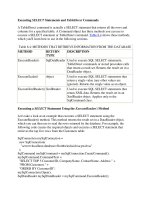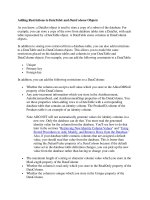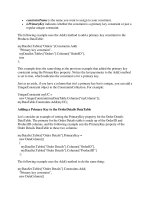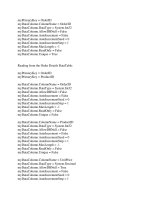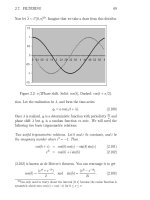Executing SELECT Statements and TableDirect Commands phần 2
Bạn đang xem bản rút gọn của tài liệu. Xem và tải ngay bản đầy đủ của tài liệu tại đây (31.19 KB, 11 trang )
Listing 8.3: SCHEMAONLYCOMMANDBEHAVIOR.CS
/*
SchemaOnlyCommandBehavior.cs illustrates how to read a table schema
*/
using System;
using System.Data;
using System.Data.SqlClient;
class SchemaOnlyCommandBehavior
{
public static void Main()
{
SqlConnection mySqlConnection =
new SqlConnection(
"server=localhost;database=Northwind;uid=sa;pwd=sa"
);
SqlCommand mySqlCommand = mySqlConnection.CreateCommand();
mySqlCommand.CommandText =
"SELECT ProductID, ProductName, UnitPrice " +
"FROM Products " +
"WHERE ProductID = 1";
mySqlConnection.Open();
// pass the CommandBehavior.SchemaOnly constant to the
// ExecuteReader() method to get the schema
SqlDataReader productsSqlDataReader =
mySqlCommand.ExecuteReader(CommandBehavior.SchemaOnly);
// read the DataTable containing the schema from the DataReader
DataTable myDataTable = productsSqlDataReader.GetSchemaTable();
// display the rows and columns in the DataTable
foreach (DataRow myDataRow in myDataTable.Rows)
{
Console.WriteLine("\nNew column details follow:");
foreach (DataColumn myDataColumn in myDataTable.Columns)
{
Console.WriteLine(myDataColumn + "= " +
myDataRow[myDataColumn]);
if (myDataColumn.ToString() == "ProviderType")
{
Console.WriteLine(myDataColumn + "= " +
((System.Data.SqlDbType) myDataRow[myDataColumn]));
}
}
}
productsSqlDataReader.Close();
mySqlConnection.Close();
}
}
You should notice the different details for the ProductID, ProductName, and UnitPrice
columns in the output that follows:
New column details follow:
ColumnName = ProductID
ColumnOrdinal = 0
ColumnSize = 4
NumericPrecision = 0
NumericScale = 0
IsUnique =
IsKey =
BaseCatalogName =
BaseColumnName = ProductID
BaseSchemaName =
BaseTableName =
DataType = System.Int32
AllowDBNull = False
ProviderType = 8
ProviderType = Int
IsAliased =
IsExpression =
IsIdentity = True
IsAutoIncrement = True
IsRowVersion =
IsHidden =
IsLong = False
IsReadOnly = True
New column details follow:
ColumnName = ProductName
ColumnOrdinal = 1
ColumnSize = 40
NumericPrecision = 0
NumericScale = 0
IsUnique =
IsKey =
BaseCatalogName =
BaseColumnName = ProductName
BaseSchemaName =
BaseTableName =
DataType = System.String
AllowDBNull = False
ProviderType = 12
ProviderType = NVarChar
IsAliased =
IsExpression =
IsIdentity = False
IsAutoIncrement = False
IsRowVersion =
IsHidden =
IsLong = False
IsReadOnly = False
New column details follow:
ColumnName = UnitPrice
ColumnOrdinal = 2
ColumnSize = 8
NumericPrecision = 0
NumericScale = 0
IsUnique =
IsKey =
BaseCatalogName =
BaseColumnName = UnitPrice
BaseSchemaName =
BaseTableName =
DataType = System.Decimal
AllowDBNull = True
ProviderType = 9
ProviderType = Money
IsAliased =
IsExpression =
IsIdentity = False
IsAutoIncrement = False
IsRowVersion =
IsHidden =
IsLong = False
IsReadOnly = False
Executing a TableDirect Statement Using the ExecuteReader() Method
When you set the CommandType property of a Command object to TableDirect, you
specify that you want to retrieve all the rows and columns of a particular table. You
specify the name of the table to retrieve from in the CommandText property.
Warning SqlCommand objects don't support the CommandType of TableDirect. The
example in this section will use an OleDbCommand object instead.
As you know, you can use a SqlConnection object to connect to SQL Server. You can
also use an OleDbConnection object to connect to SQL Server. You simply set the
provider to SQLOLEDB in the connection string passed to the OleDbConnection
constructor. For example:
OleDbConnection myOleDbConnection =
new OleDbConnection(
"Provider=SQLOLEDB;server=localhost;database=Northwind;" +
"uid=sa;pwd=sa"
);
Next, you create an OleDbConnection object:
OleDbCommand myOleDbCommand = myOleDbConnection.CreateCommand();
You then set the CommandType of myOleDbConnection to CommandType.TableDirect:
myOleDbCommand.CommandType = CommandType.TableDirect;
Next, you specify the name of the table to retrieve from using the CommandText
property. The following example sets the CommandText property of myOleDbCommand
to Products:
myOleDbCommand.CommandText = "Products";
You next open the database connection:
myOleDbConnection.Open();
Finally, you execute myOleDbCommand using the ExecuteReader() method:
OleDbDataReader myOleDbDataReader = myOleDbCommand.ExecuteReader();
The SQL statement actually executed is SELECT * FROM Products, which retrieves all
the rows and columns from the Products table.
Listing 8.4
illustrates the code shown in this section.
Listing 8.4: EXECUTETABLEDIRECT.CS
/*
ExecuteTableDirect.cs illustrates how to execute a
TableDirect command
*/
using System;
using System.Data;
using System.Data.OleDb;
class ExecuteTableDirect
{
public static void Main()
{
OleDbConnection myOleDbConnection =
new OleDbConnection(
"Provider=SQLOLEDB;server=localhost;database=Northwind;" +
"uid=sa;pwd=sa"
);
OleDbCommand myOleDbCommand = myOleDbConnection.CreateCommand();
// set the CommandType property of the OleDbCommand object to
// TableDirect
myOleDbCommand.CommandType = CommandType.TableDirect;
// set the CommandText property of the OleDbCommand object to
// the name of the table to retrieve from
myOleDbCommand.CommandText = "Products";
myOleDbConnection.Open();
OleDbDataReader myOleDbDataReader = myOleDbCommand.ExecuteReader();
// only read the first 5 rows from the OleDbDataReader object
for (int count = 1; count <= 5; count++)
{
